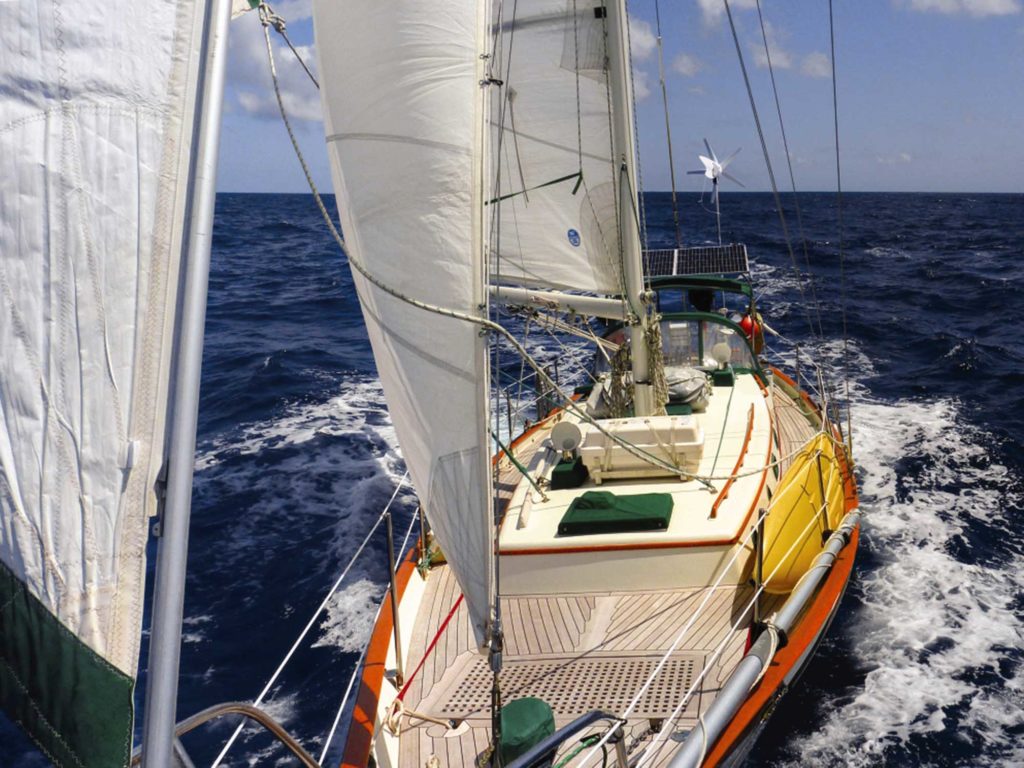
This year we sailed from the Mediterranean to the Canary Islands, down the West African coast to Cabo Verde, then right across the Atlantic Ocean to the Caribbean—over 4,000 nautical miles, and while underway, not once did we run our engine or generator for power or propulsion. For a whole month of sailing, we were driven entirely by the wind, sun and sea.
Compliments of Mother Nature, our B&G autopilot, sailing instruments, chart plotter, VHF, AIS, satellite phone, fridge/freezer compressor, lights and entertainment all ran on clean, natural, renewable energy. We even operated our Spectra Ventura 12-volt watermaker every three to five days when the sun was high, and had enough juice to run our Mastervolt inverter to charge our electric toothbrushes. In fact, we regularly had more incoming power than we needed and frequently restrained the wind generator to manage our charge during the day.
We didn’t always have such a green wake or an abundance of amps. When my wife, Catherine, and I set off from New York in 2007, Dream Time, our 38-foot Cabo Rico, sported just an Ampair wind generator and one feeble flexible solar panel sagging over the Bimini. On a really good day, both would generate about 5 to 6 amps—just enough to keep the beer cold. We made it as far as Florida before realizing an upgrade to our renewable-energy source was necessary. We replaced the single flexible solar panel with two 85-watt panels, the fore/aft angle of which can be adjusted to face the sun. A few years later, in New Zealand, we replaced our Ampair wind generator with a D400, and a few more sea miles after that, in the Northern Territory of Australia, we bought a secondhand hydrogenerator from a local sailor, rebuilt the unit and added it to our arsenal of passagemaking power.
Since our original upgrades, we’ve gone weeks at anchor in the tropics without having to burn fuel to charge our two 225-amp-hour gel house batteries. The solar panels provide 10 to 12 amps when the sun is high, while our D400 wind generator adds another 10 to 15 amps when the trades are steady. Combined, it’s more than enough to give us complete off-the-grid freedom to power our floating home, make water and run the inverter for a few hours every evening. But passagemaking was always a charging challenge because sail shadows would, at some point in the day, cover our solar panels, and as we spend most of our time going with the breeze rather than against it, the apparent wind speed for our D400 would drop by 30 percent.
Cruising catamarans typically have plenty of surface area and can comfortably carry 500 watts of solar panels, and even twin wind generators, one for each hull, without looking cluttered. But for a modest-size monohull where space is at a premium, unless you don’t mind your boat looking like an overloaded pack mule or having an engine thumping away in the hull a few hours a day just to boost your volts, finding balance between power consumption and renewable energy can be a little more challenging.
Our voyage across the Atlantic wasn’t our fastest —under mostly sunny skies, we averaged a respectable 6 knots, with 15 to 20 knots of wind blowing steadily across our stern—but it was the first offshore passage during which we’d been able to tow our Aquair hydrogenerator. The unit produced a little less than 1 amp for every knot of boatspeed, contributing up to 5 amps—faster speeds did not result in an increase of current and only had the unit’s prop whizzing and leaping from waves like a hooked mahi. Some cruisers attach anodes to the propeller shaft to increase its weight, but for Dream Time, this would rarely be necessary. The 100 feet of trailing line and propeller made no discernible difference to boatspeed, and like our wind generator, provided steady, reliable power 24 hours a day, allowing Dream Time to sail quietly through the night, with volts rarely falling below 12.6.
Since we left New York, we have sailed 48,000 nautical miles, and we have found a balance on Dream Time, one that we never imagined possible 13 years ago. Our independence and the security we feel that comes from our self-reliance are among the most valuable discoveries we have made on our long voyage around the world. There is an intimacy and awareness to the moment that comes when living on a small boat sailing far from the noise and distraction of a modern life. And there is a most satisfying freedom, a harmony that comes from crossing oceans, exploring the world under sail, powered entirely by the wind, sun and sea.








